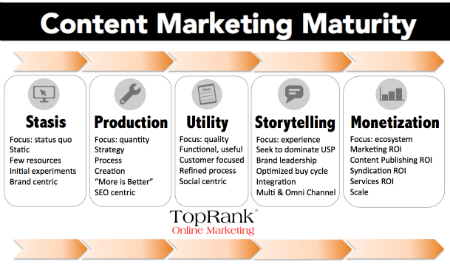This Spiderman aims to please, but he’s just not the real thing
As someone with roots in the search marketing community it’s been amazing to see how the the phrase “content marketing” has been adopted and redefined.
Whether it’s opportunism or simply being adaptable to the times, the difference in approach to what content marketing is between digital marketing communities like Content Marketing Institute and many in the SEO and social media marketing world is striking.
For brands investing in content marketing, the difference between content for links and SEO and content for customers can be costly in terms of risk, return on investment and performance.
What’s the difference?
Content Marketing as More Content – Those who define content marketing as creating “more content”, especially search engine optimized content, tend to be focused on performance metrics like search visibility and keyword oriented traffic. As with all SEO, the logic is that increased search visibility will lead to more traffic which will lead to more leads and sales.
Content Marketing as Customer Experience – When you look at the long standing custom publishing industry and brand creation of content and media, the focus tends to be on understand the specific interests, goals and information expectations of a particular audience segment. Mapping out the customer journey from awareness to consideration to purchase for each customer segment surfaces the questions buyers have throughout the sales cycle.
Content Marketing in this context is the planning, creation and promotion of content for a target audience segment to answer their questions and guide them along the sales cycle from awareness to transaction. Tactics like SEO, social media marketing, advertising, media relations and email are used to amplify that content for discovery.
Why does it matter?
If your company is buying content marketing purely for SEO reasons, then it’s likely that your editorial plan is driven by popular, relevant keywords and not the specific interests of your target customers. Keywords first is a strategy that drives content quantity (not quality) to achieve as many “hooks in the water” within search results as possible. Essentially, it’s a model with a focus on optimizing for search engines, not customers.
I would argue that investing in a quantity of content for search and not a customer-focused experience, can be costly for companies. The content might “rank” in search, but how does it contribute to the buyer experience? How does it advance how you want your brand to be known? How defensible is SEO content with increasing quality guidelines from search engines?
Understand your customers and the buying cycle first. Plan content according to the customer journey, THEN apply keyword optimization and SEO tactics. Keywords are important – absolutely. But in the long run, the most return on content marketing investments will come from optimizing for the customer experience and using SEO as a tool for relevant amplification – not letting SEO alone drive content ideation and creation.
Where I’m coming from with this
With our agency’s combined practice areas in PR, Traditional Marketing and Search since 2001, content creation and messaging strategy have always been a part of what we do. At the same time, exposure to the direct marketing and email marketing industry with customer segmentation and buying cycles have been great perquisites for how content marketing is practiced by many brands and advocated by organizations like the Content Marketing Institute.
As a result, we’ve been able to achieve a footprint on the web and in the business community that brings 100% of our new business in through inbound means – no advertising and no sales people. AND with only 1 person dedicated to the marketing function. Our boutique agency is known all over the world and competes with other agencies 10 or 20 x our size that spend massive budgets on business development and advertising. The cost of sale for our agency and our clients who subscribe to a customer first content marketing approach is mostly answering questions when people email or call to buy.
Making the Transition from Content Quantity to Creating Content Experience

TopRank’s Content Marketing Maturity Model
In order for companies to successfully adopt content creation and marketing, a clear understanding must be achieved in terms of how a content marketing program can help a company achieve its goals, how a content investment will help customers move along the sales cycle and what resources, processes and tactics will be necessary to make it all happen.
It’s a customer focused approach that eventually becomes a high performing channel for new, inbound customer acquisition. In fact, really good content marketing programs that mature are so good, they’re able to monetize beyond attracting leads and sales. Monetized content marketing is content that is so good, people are willing to pay for it.
Are SEO and social media still important? Of course! But focus on your customers with a content marketing program. Expect your consultant or internal marketers to use customer insights and the sales cycle to drive content creation, and then optimize that content for marketing performance.
![]()
Gain a competitive advantage by subscribing to the
TopRank® Online Marketing Newsletter.
© Online Marketing Blog, 2014. |
What’s the Difference Between Content Marketing and Content for Links? The Wrong Answer Could Cost You | http://www.toprankblog.com
Source: TOP Rank Blog
What’s the Difference Between Content Marketing and Content for Links? The Wrong Answer Could Cost You

No comments:
Post a Comment